CNMT220: IBM's Organizational Change Management Over 30 Years
VerifiedAdded on 2023/04/21
|12
|1845
|333
Report
AI Summary
This report examines the significant organizational changes that have occurred at IBM from 1985 to 2018. The report imagines an employee, Mr. Rip Van Winkle, who awakens after 30 years to observe the transformations within IBM. It details the evolution of office layouts from corner offices to open plans, the rapid advancements in technological tools from PCs to smartphones, and the shifts in employee dress codes towards greater flexibility. The report also highlights IBM's commitment to diversity and its employee-centric work culture, emphasizing health and well-being. Furthermore, it discusses changes in business processes, including international growth and outsourcing. The conclusion summarizes these changes, emphasizing IBM's adaptation to a globalized market and its focus on employee satisfaction and innovative business practices. The report is based on the student's assignment for the Change Management unit.

Running Head: IBM 0
Organizational Change Management
Student Details
2/17/2019
Organizational Change Management
Student Details
2/17/2019
Paraphrase This Document
Need a fresh take? Get an instant paraphrase of this document with our AI Paraphraser
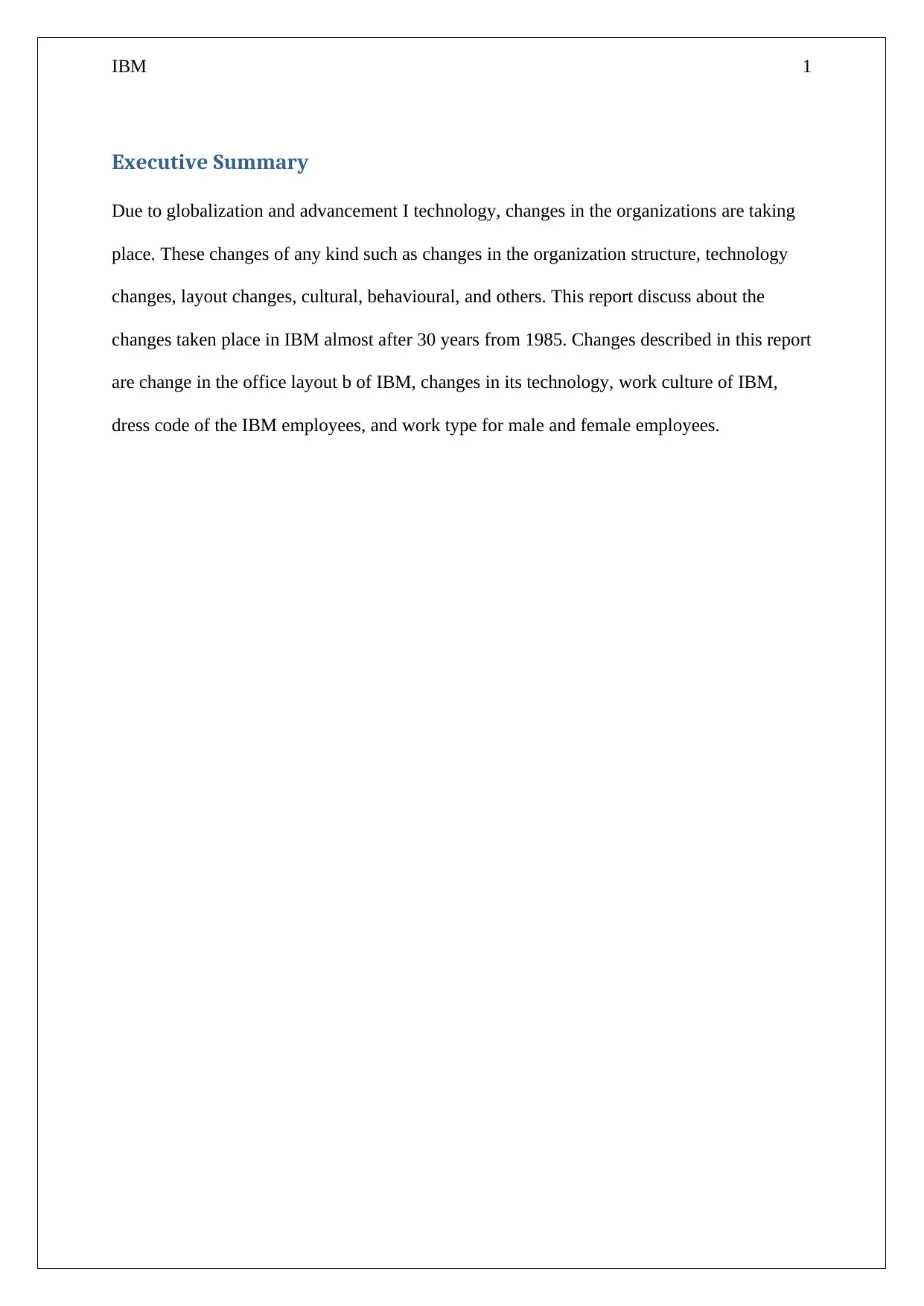
IBM 1
Executive Summary
Due to globalization and advancement I technology, changes in the organizations are taking
place. These changes of any kind such as changes in the organization structure, technology
changes, layout changes, cultural, behavioural, and others. This report discuss about the
changes taken place in IBM almost after 30 years from 1985. Changes described in this report
are change in the office layout b of IBM, changes in its technology, work culture of IBM,
dress code of the IBM employees, and work type for male and female employees.
Executive Summary
Due to globalization and advancement I technology, changes in the organizations are taking
place. These changes of any kind such as changes in the organization structure, technology
changes, layout changes, cultural, behavioural, and others. This report discuss about the
changes taken place in IBM almost after 30 years from 1985. Changes described in this report
are change in the office layout b of IBM, changes in its technology, work culture of IBM,
dress code of the IBM employees, and work type for male and female employees.
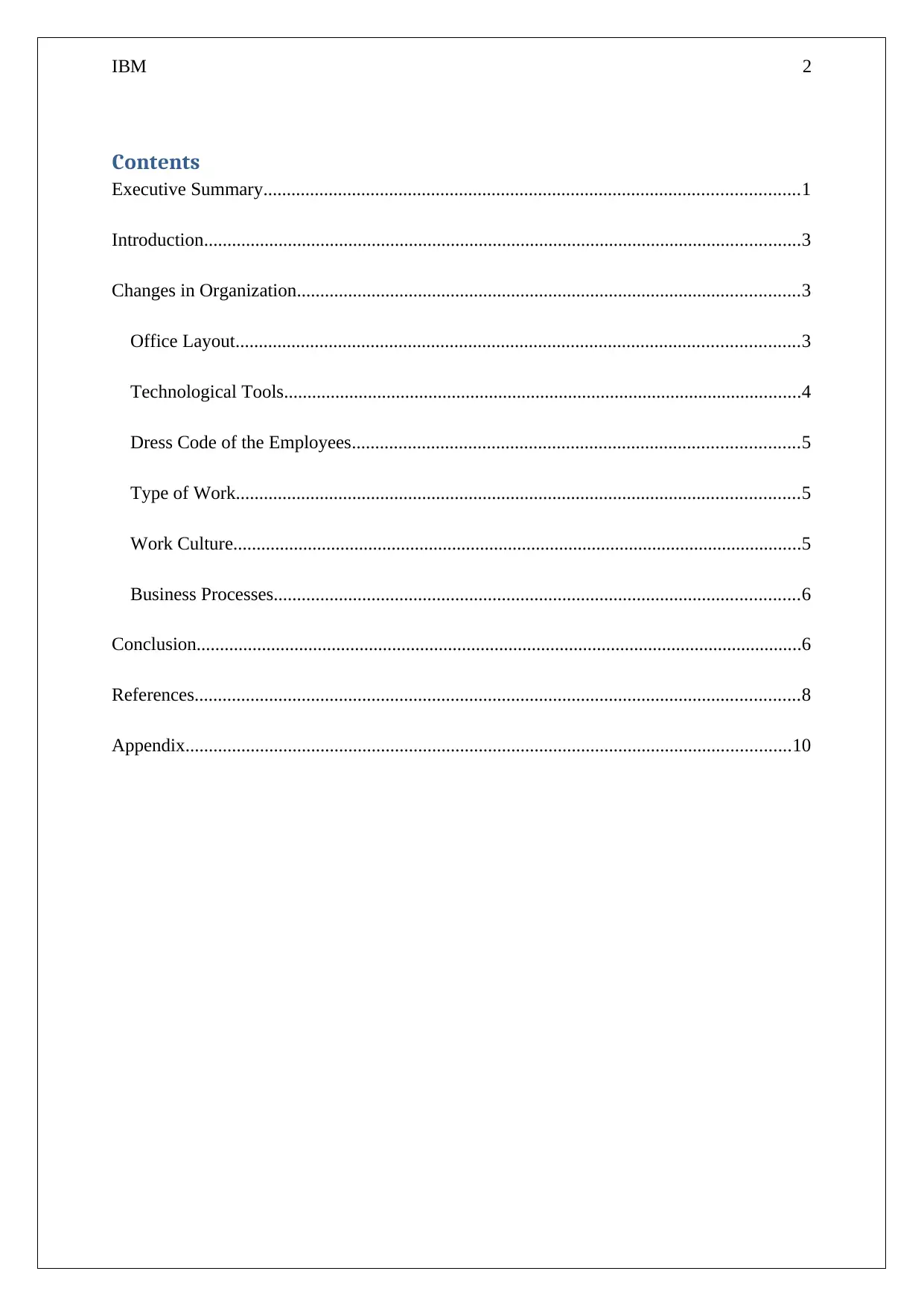
IBM 2
Contents
Executive Summary...................................................................................................................1
Introduction................................................................................................................................3
Changes in Organization............................................................................................................3
Office Layout.........................................................................................................................3
Technological Tools...............................................................................................................4
Dress Code of the Employees................................................................................................5
Type of Work.........................................................................................................................5
Work Culture..........................................................................................................................5
Business Processes.................................................................................................................6
Conclusion..................................................................................................................................6
References..................................................................................................................................8
Appendix..................................................................................................................................10
Contents
Executive Summary...................................................................................................................1
Introduction................................................................................................................................3
Changes in Organization............................................................................................................3
Office Layout.........................................................................................................................3
Technological Tools...............................................................................................................4
Dress Code of the Employees................................................................................................5
Type of Work.........................................................................................................................5
Work Culture..........................................................................................................................5
Business Processes.................................................................................................................6
Conclusion..................................................................................................................................6
References..................................................................................................................................8
Appendix..................................................................................................................................10
You're viewing a preview
Unlock full access by subscribing today!
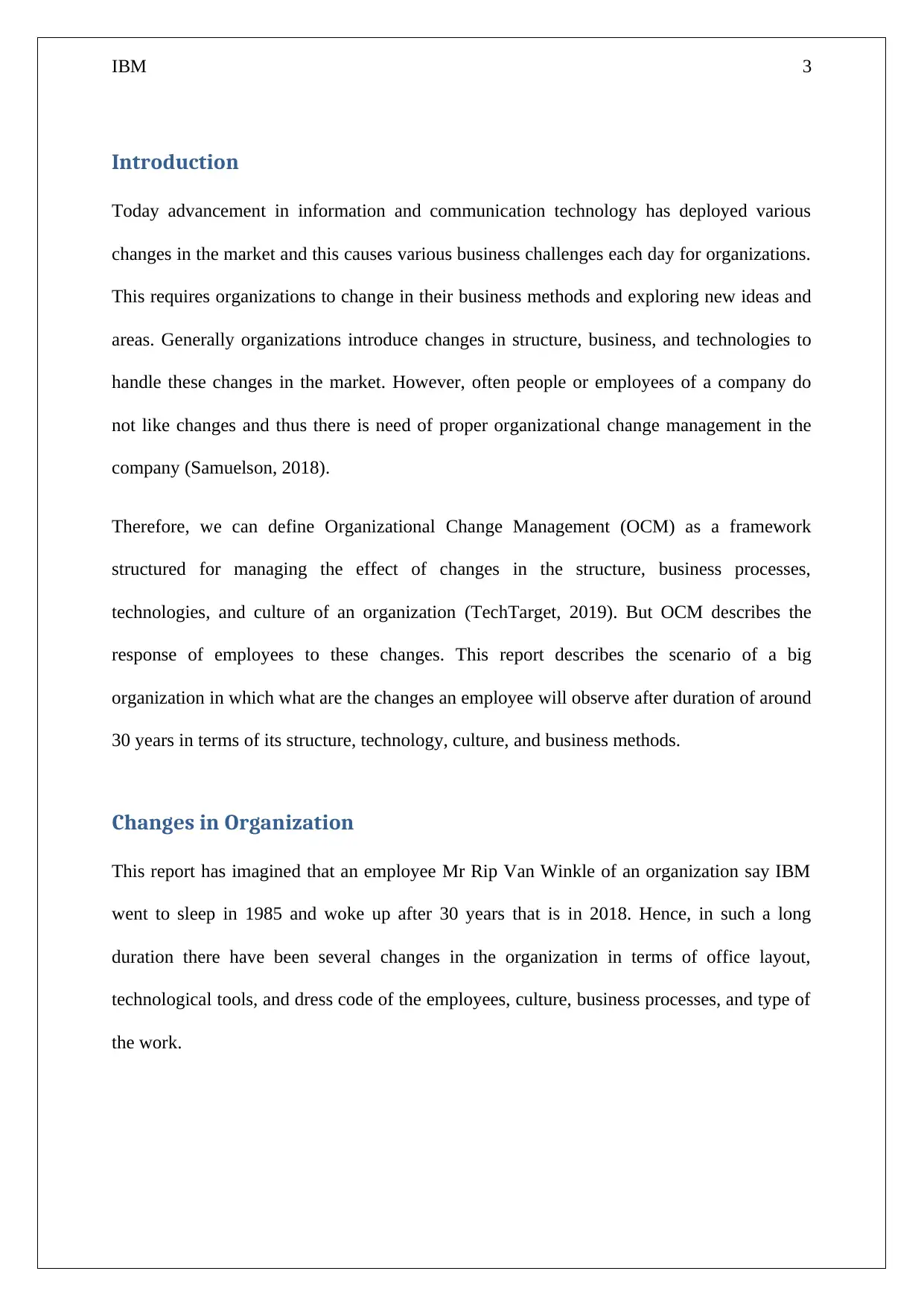
IBM 3
Introduction
Today advancement in information and communication technology has deployed various
changes in the market and this causes various business challenges each day for organizations.
This requires organizations to change in their business methods and exploring new ideas and
areas. Generally organizations introduce changes in structure, business, and technologies to
handle these changes in the market. However, often people or employees of a company do
not like changes and thus there is need of proper organizational change management in the
company (Samuelson, 2018).
Therefore, we can define Organizational Change Management (OCM) as a framework
structured for managing the effect of changes in the structure, business processes,
technologies, and culture of an organization (TechTarget, 2019). But OCM describes the
response of employees to these changes. This report describes the scenario of a big
organization in which what are the changes an employee will observe after duration of around
30 years in terms of its structure, technology, culture, and business methods.
Changes in Organization
This report has imagined that an employee Mr Rip Van Winkle of an organization say IBM
went to sleep in 1985 and woke up after 30 years that is in 2018. Hence, in such a long
duration there have been several changes in the organization in terms of office layout,
technological tools, and dress code of the employees, culture, business processes, and type of
the work.
Introduction
Today advancement in information and communication technology has deployed various
changes in the market and this causes various business challenges each day for organizations.
This requires organizations to change in their business methods and exploring new ideas and
areas. Generally organizations introduce changes in structure, business, and technologies to
handle these changes in the market. However, often people or employees of a company do
not like changes and thus there is need of proper organizational change management in the
company (Samuelson, 2018).
Therefore, we can define Organizational Change Management (OCM) as a framework
structured for managing the effect of changes in the structure, business processes,
technologies, and culture of an organization (TechTarget, 2019). But OCM describes the
response of employees to these changes. This report describes the scenario of a big
organization in which what are the changes an employee will observe after duration of around
30 years in terms of its structure, technology, culture, and business methods.
Changes in Organization
This report has imagined that an employee Mr Rip Van Winkle of an organization say IBM
went to sleep in 1985 and woke up after 30 years that is in 2018. Hence, in such a long
duration there have been several changes in the organization in terms of office layout,
technological tools, and dress code of the employees, culture, business processes, and type of
the work.
Paraphrase This Document
Need a fresh take? Get an instant paraphrase of this document with our AI Paraphraser
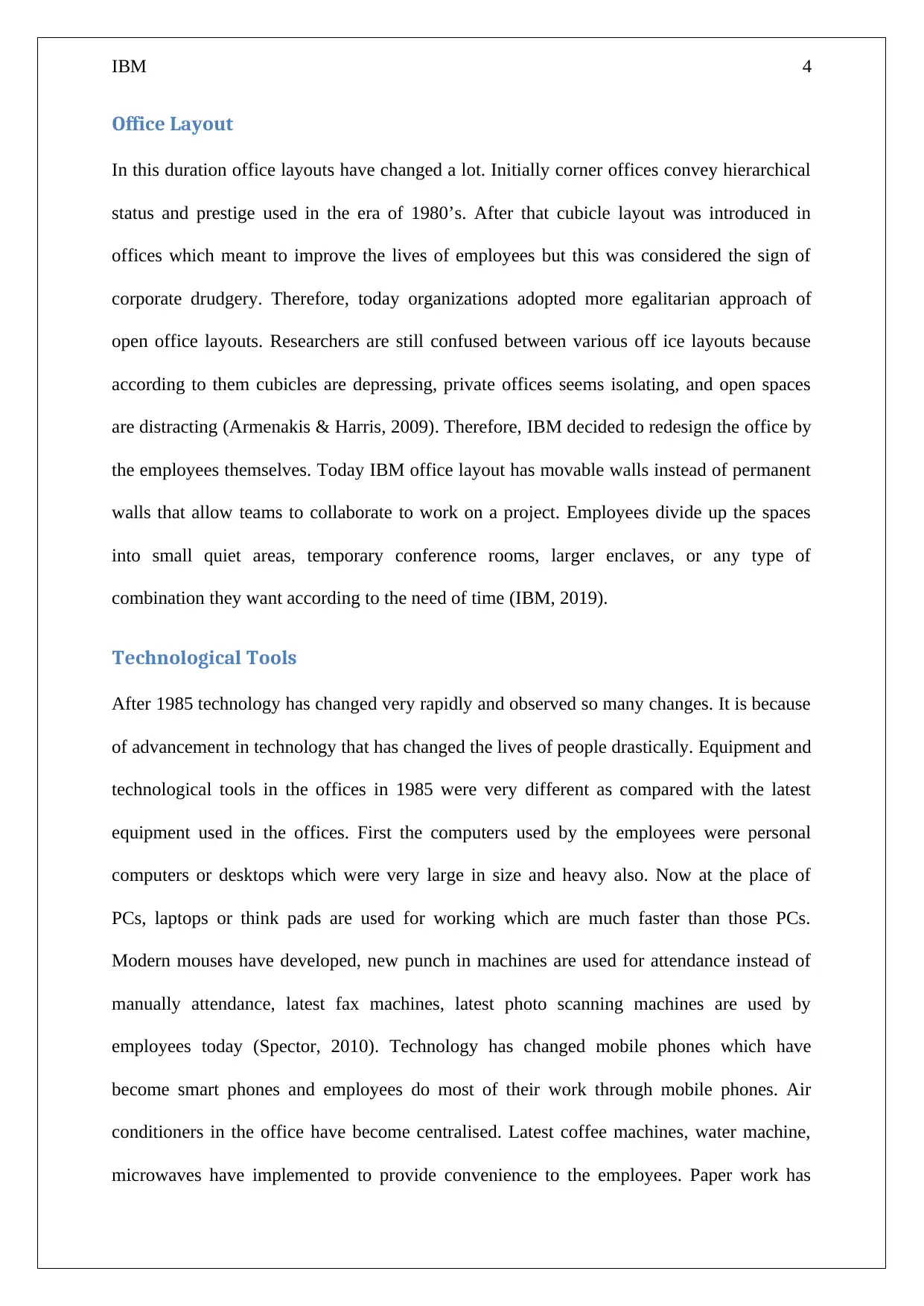
IBM 4
Office Layout
In this duration office layouts have changed a lot. Initially corner offices convey hierarchical
status and prestige used in the era of 1980’s. After that cubicle layout was introduced in
offices which meant to improve the lives of employees but this was considered the sign of
corporate drudgery. Therefore, today organizations adopted more egalitarian approach of
open office layouts. Researchers are still confused between various off ice layouts because
according to them cubicles are depressing, private offices seems isolating, and open spaces
are distracting (Armenakis & Harris, 2009). Therefore, IBM decided to redesign the office by
the employees themselves. Today IBM office layout has movable walls instead of permanent
walls that allow teams to collaborate to work on a project. Employees divide up the spaces
into small quiet areas, temporary conference rooms, larger enclaves, or any type of
combination they want according to the need of time (IBM, 2019).
Technological Tools
After 1985 technology has changed very rapidly and observed so many changes. It is because
of advancement in technology that has changed the lives of people drastically. Equipment and
technological tools in the offices in 1985 were very different as compared with the latest
equipment used in the offices. First the computers used by the employees were personal
computers or desktops which were very large in size and heavy also. Now at the place of
PCs, laptops or think pads are used for working which are much faster than those PCs.
Modern mouses have developed, new punch in machines are used for attendance instead of
manually attendance, latest fax machines, latest photo scanning machines are used by
employees today (Spector, 2010). Technology has changed mobile phones which have
become smart phones and employees do most of their work through mobile phones. Air
conditioners in the office have become centralised. Latest coffee machines, water machine,
microwaves have implemented to provide convenience to the employees. Paper work has
Office Layout
In this duration office layouts have changed a lot. Initially corner offices convey hierarchical
status and prestige used in the era of 1980’s. After that cubicle layout was introduced in
offices which meant to improve the lives of employees but this was considered the sign of
corporate drudgery. Therefore, today organizations adopted more egalitarian approach of
open office layouts. Researchers are still confused between various off ice layouts because
according to them cubicles are depressing, private offices seems isolating, and open spaces
are distracting (Armenakis & Harris, 2009). Therefore, IBM decided to redesign the office by
the employees themselves. Today IBM office layout has movable walls instead of permanent
walls that allow teams to collaborate to work on a project. Employees divide up the spaces
into small quiet areas, temporary conference rooms, larger enclaves, or any type of
combination they want according to the need of time (IBM, 2019).
Technological Tools
After 1985 technology has changed very rapidly and observed so many changes. It is because
of advancement in technology that has changed the lives of people drastically. Equipment and
technological tools in the offices in 1985 were very different as compared with the latest
equipment used in the offices. First the computers used by the employees were personal
computers or desktops which were very large in size and heavy also. Now at the place of
PCs, laptops or think pads are used for working which are much faster than those PCs.
Modern mouses have developed, new punch in machines are used for attendance instead of
manually attendance, latest fax machines, latest photo scanning machines are used by
employees today (Spector, 2010). Technology has changed mobile phones which have
become smart phones and employees do most of their work through mobile phones. Air
conditioners in the office have become centralised. Latest coffee machines, water machine,
microwaves have implemented to provide convenience to the employees. Paper work has
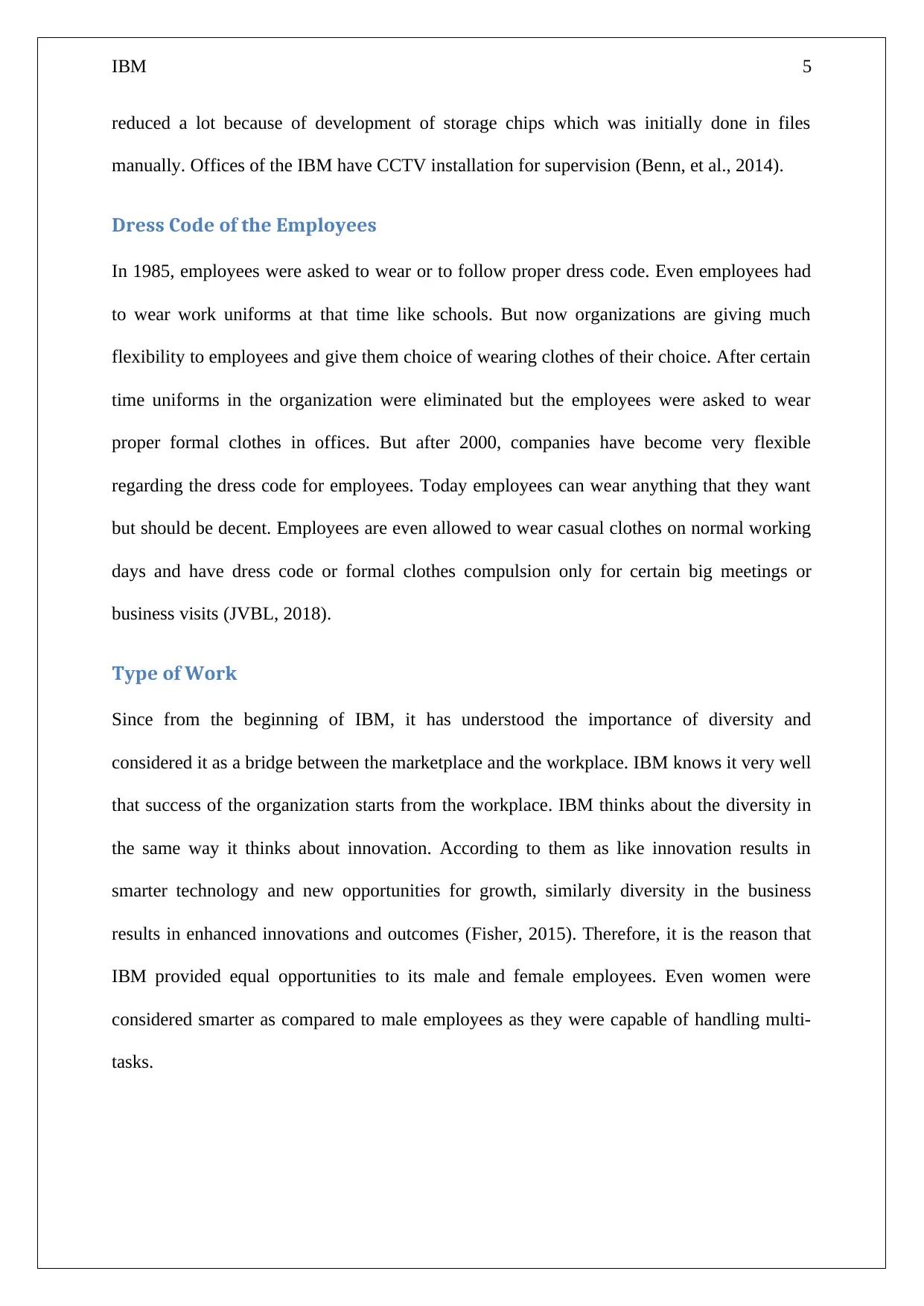
IBM 5
reduced a lot because of development of storage chips which was initially done in files
manually. Offices of the IBM have CCTV installation for supervision (Benn, et al., 2014).
Dress Code of the Employees
In 1985, employees were asked to wear or to follow proper dress code. Even employees had
to wear work uniforms at that time like schools. But now organizations are giving much
flexibility to employees and give them choice of wearing clothes of their choice. After certain
time uniforms in the organization were eliminated but the employees were asked to wear
proper formal clothes in offices. But after 2000, companies have become very flexible
regarding the dress code for employees. Today employees can wear anything that they want
but should be decent. Employees are even allowed to wear casual clothes on normal working
days and have dress code or formal clothes compulsion only for certain big meetings or
business visits (JVBL, 2018).
Type of Work
Since from the beginning of IBM, it has understood the importance of diversity and
considered it as a bridge between the marketplace and the workplace. IBM knows it very well
that success of the organization starts from the workplace. IBM thinks about the diversity in
the same way it thinks about innovation. According to them as like innovation results in
smarter technology and new opportunities for growth, similarly diversity in the business
results in enhanced innovations and outcomes (Fisher, 2015). Therefore, it is the reason that
IBM provided equal opportunities to its male and female employees. Even women were
considered smarter as compared to male employees as they were capable of handling multi-
tasks.
reduced a lot because of development of storage chips which was initially done in files
manually. Offices of the IBM have CCTV installation for supervision (Benn, et al., 2014).
Dress Code of the Employees
In 1985, employees were asked to wear or to follow proper dress code. Even employees had
to wear work uniforms at that time like schools. But now organizations are giving much
flexibility to employees and give them choice of wearing clothes of their choice. After certain
time uniforms in the organization were eliminated but the employees were asked to wear
proper formal clothes in offices. But after 2000, companies have become very flexible
regarding the dress code for employees. Today employees can wear anything that they want
but should be decent. Employees are even allowed to wear casual clothes on normal working
days and have dress code or formal clothes compulsion only for certain big meetings or
business visits (JVBL, 2018).
Type of Work
Since from the beginning of IBM, it has understood the importance of diversity and
considered it as a bridge between the marketplace and the workplace. IBM knows it very well
that success of the organization starts from the workplace. IBM thinks about the diversity in
the same way it thinks about innovation. According to them as like innovation results in
smarter technology and new opportunities for growth, similarly diversity in the business
results in enhanced innovations and outcomes (Fisher, 2015). Therefore, it is the reason that
IBM provided equal opportunities to its male and female employees. Even women were
considered smarter as compared to male employees as they were capable of handling multi-
tasks.
You're viewing a preview
Unlock full access by subscribing today!
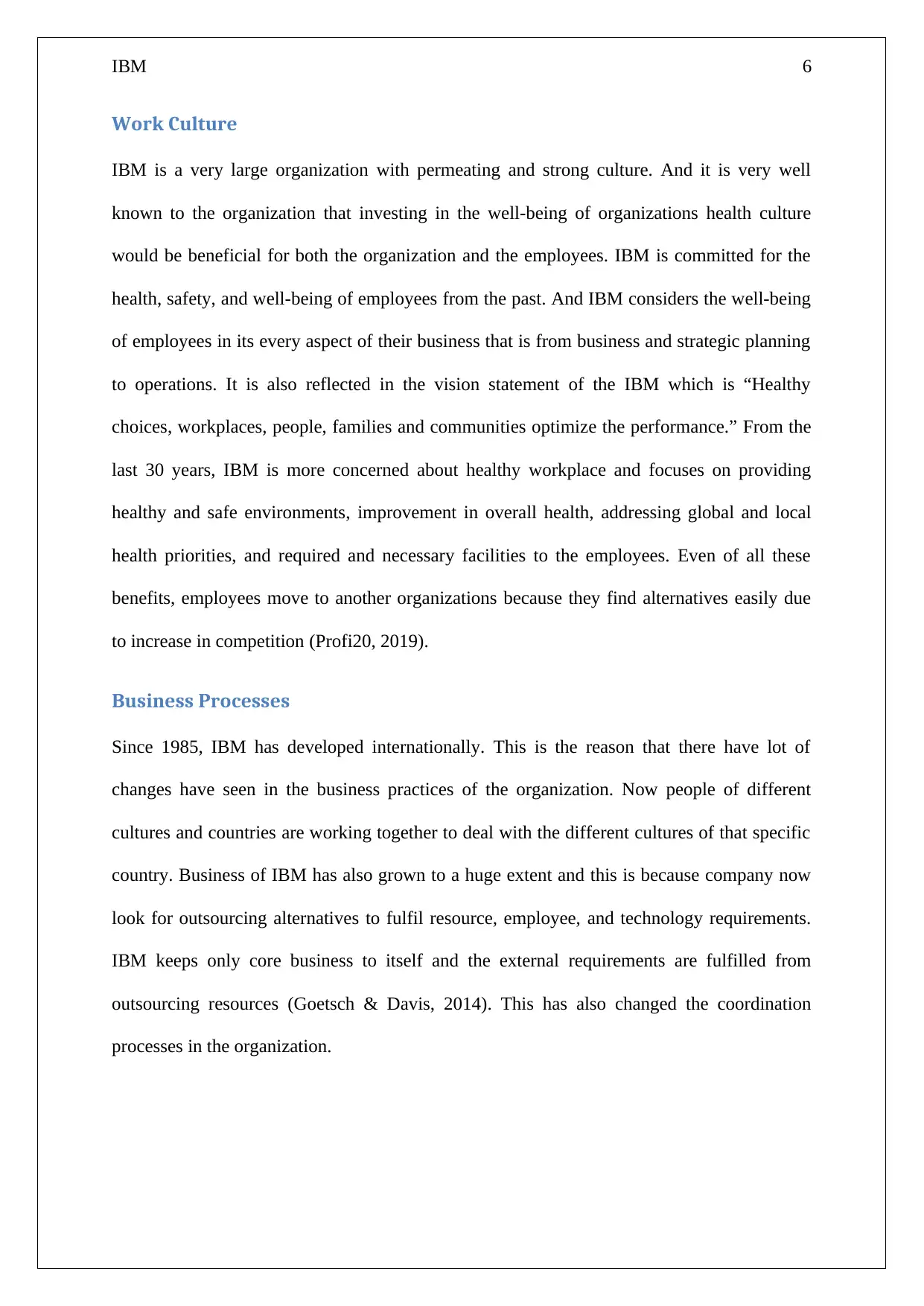
IBM 6
Work Culture
IBM is a very large organization with permeating and strong culture. And it is very well
known to the organization that investing in the well-being of organizations health culture
would be beneficial for both the organization and the employees. IBM is committed for the
health, safety, and well-being of employees from the past. And IBM considers the well-being
of employees in its every aspect of their business that is from business and strategic planning
to operations. It is also reflected in the vision statement of the IBM which is “Healthy
choices, workplaces, people, families and communities optimize the performance.” From the
last 30 years, IBM is more concerned about healthy workplace and focuses on providing
healthy and safe environments, improvement in overall health, addressing global and local
health priorities, and required and necessary facilities to the employees. Even of all these
benefits, employees move to another organizations because they find alternatives easily due
to increase in competition (Profi20, 2019).
Business Processes
Since 1985, IBM has developed internationally. This is the reason that there have lot of
changes have seen in the business practices of the organization. Now people of different
cultures and countries are working together to deal with the different cultures of that specific
country. Business of IBM has also grown to a huge extent and this is because company now
look for outsourcing alternatives to fulfil resource, employee, and technology requirements.
IBM keeps only core business to itself and the external requirements are fulfilled from
outsourcing resources (Goetsch & Davis, 2014). This has also changed the coordination
processes in the organization.
Work Culture
IBM is a very large organization with permeating and strong culture. And it is very well
known to the organization that investing in the well-being of organizations health culture
would be beneficial for both the organization and the employees. IBM is committed for the
health, safety, and well-being of employees from the past. And IBM considers the well-being
of employees in its every aspect of their business that is from business and strategic planning
to operations. It is also reflected in the vision statement of the IBM which is “Healthy
choices, workplaces, people, families and communities optimize the performance.” From the
last 30 years, IBM is more concerned about healthy workplace and focuses on providing
healthy and safe environments, improvement in overall health, addressing global and local
health priorities, and required and necessary facilities to the employees. Even of all these
benefits, employees move to another organizations because they find alternatives easily due
to increase in competition (Profi20, 2019).
Business Processes
Since 1985, IBM has developed internationally. This is the reason that there have lot of
changes have seen in the business practices of the organization. Now people of different
cultures and countries are working together to deal with the different cultures of that specific
country. Business of IBM has also grown to a huge extent and this is because company now
look for outsourcing alternatives to fulfil resource, employee, and technology requirements.
IBM keeps only core business to itself and the external requirements are fulfilled from
outsourcing resources (Goetsch & Davis, 2014). This has also changed the coordination
processes in the organization.
Paraphrase This Document
Need a fresh take? Get an instant paraphrase of this document with our AI Paraphraser
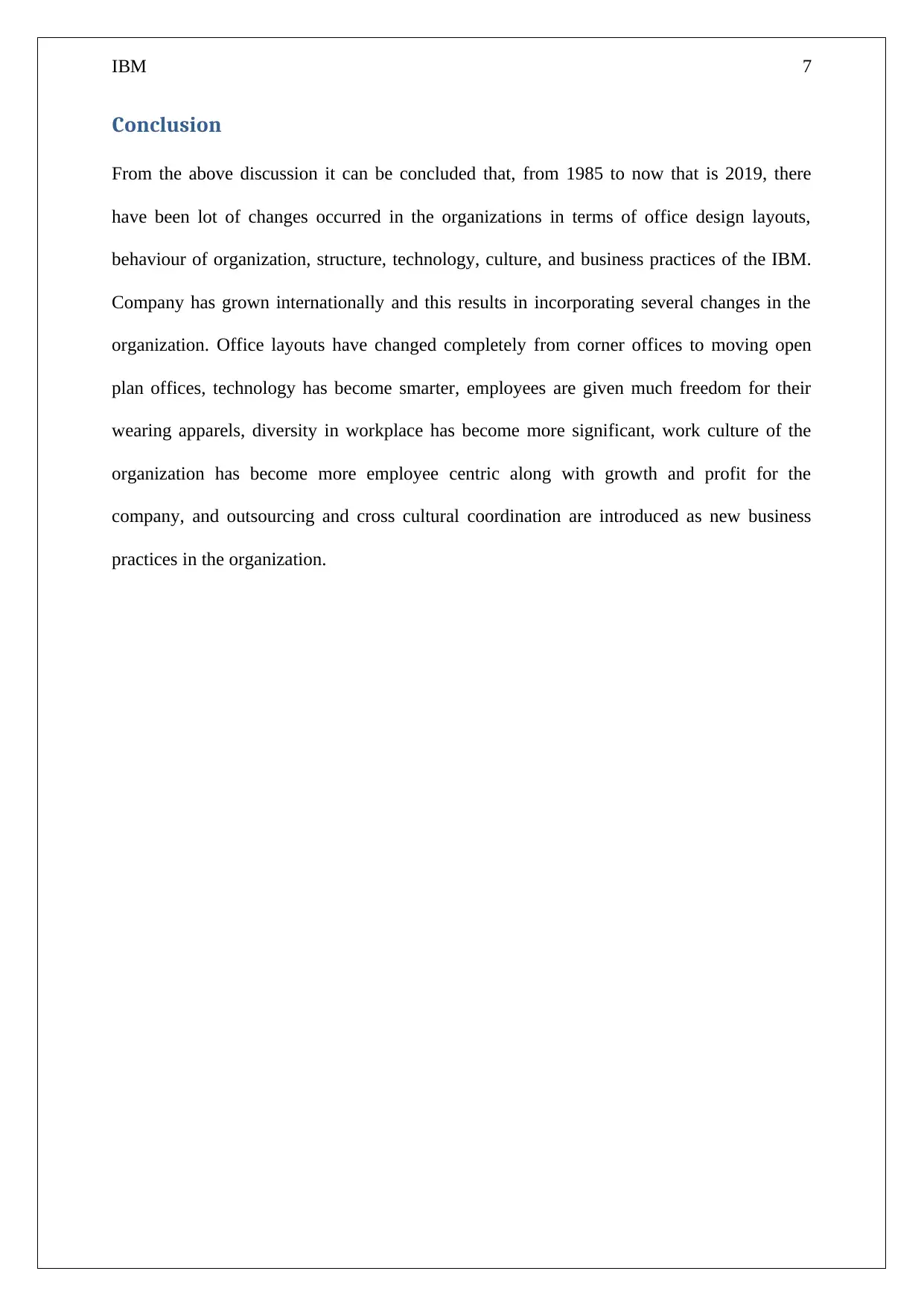
IBM 7
Conclusion
From the above discussion it can be concluded that, from 1985 to now that is 2019, there
have been lot of changes occurred in the organizations in terms of office design layouts,
behaviour of organization, structure, technology, culture, and business practices of the IBM.
Company has grown internationally and this results in incorporating several changes in the
organization. Office layouts have changed completely from corner offices to moving open
plan offices, technology has become smarter, employees are given much freedom for their
wearing apparels, diversity in workplace has become more significant, work culture of the
organization has become more employee centric along with growth and profit for the
company, and outsourcing and cross cultural coordination are introduced as new business
practices in the organization.
Conclusion
From the above discussion it can be concluded that, from 1985 to now that is 2019, there
have been lot of changes occurred in the organizations in terms of office design layouts,
behaviour of organization, structure, technology, culture, and business practices of the IBM.
Company has grown internationally and this results in incorporating several changes in the
organization. Office layouts have changed completely from corner offices to moving open
plan offices, technology has become smarter, employees are given much freedom for their
wearing apparels, diversity in workplace has become more significant, work culture of the
organization has become more employee centric along with growth and profit for the
company, and outsourcing and cross cultural coordination are introduced as new business
practices in the organization.
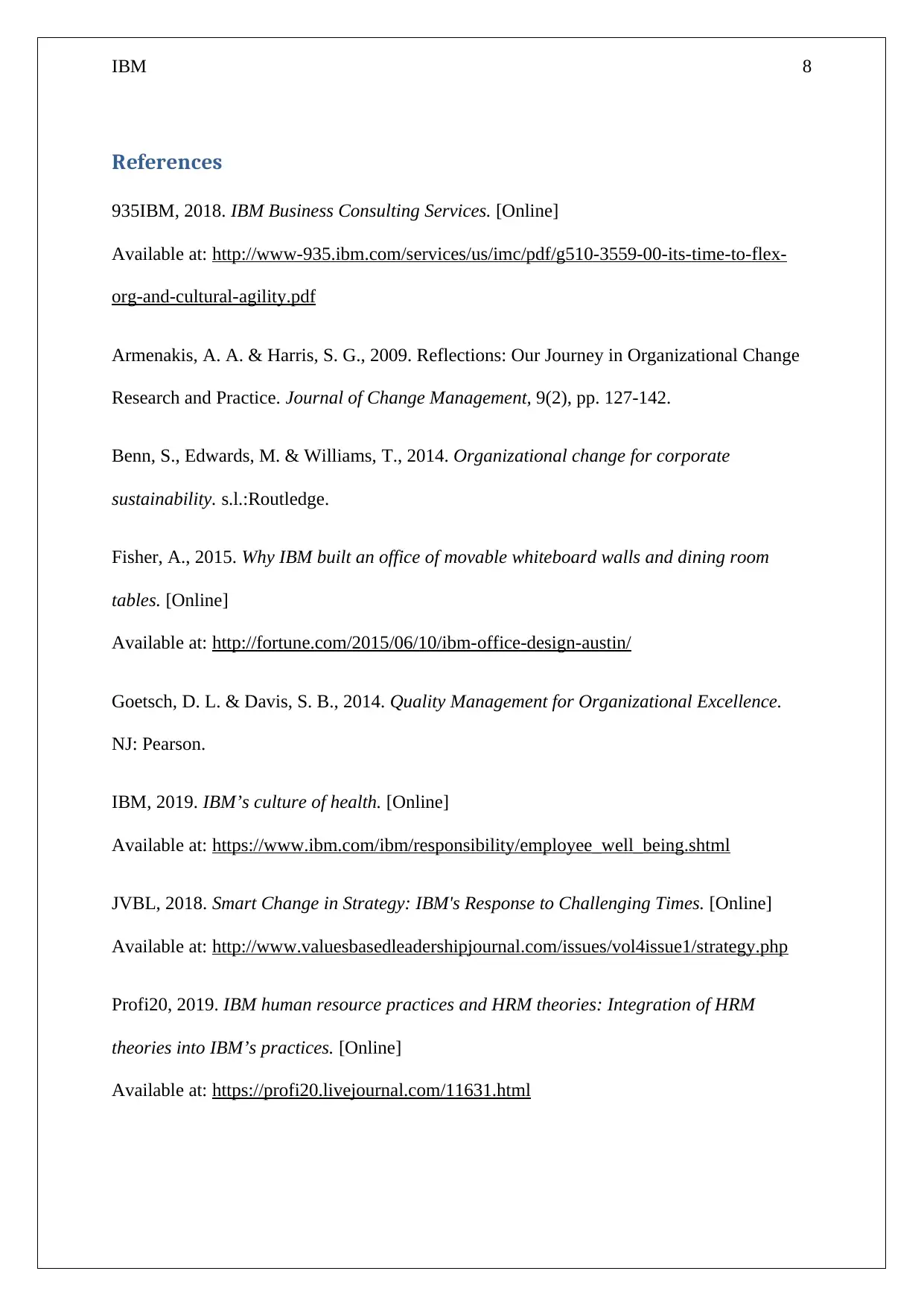
IBM 8
References
935IBM, 2018. IBM Business Consulting Services. [Online]
Available at: http://www-935.ibm.com/services/us/imc/pdf/g510-3559-00-its-time-to-flex-
org-and-cultural-agility.pdf
Armenakis, A. A. & Harris, S. G., 2009. Reflections: Our Journey in Organizational Change
Research and Practice. Journal of Change Management, 9(2), pp. 127-142.
Benn, S., Edwards, M. & Williams, T., 2014. Organizational change for corporate
sustainability. s.l.:Routledge.
Fisher, A., 2015. Why IBM built an office of movable whiteboard walls and dining room
tables. [Online]
Available at: http://fortune.com/2015/06/10/ibm-office-design-austin/
Goetsch, D. L. & Davis, S. B., 2014. Quality Management for Organizational Excellence.
NJ: Pearson.
IBM, 2019. IBM’s culture of health. [Online]
Available at: https://www.ibm.com/ibm/responsibility/employee_well_being.shtml
JVBL, 2018. Smart Change in Strategy: IBM's Response to Challenging Times. [Online]
Available at: http://www.valuesbasedleadershipjournal.com/issues/vol4issue1/strategy.php
Profi20, 2019. IBM human resource practices and HRM theories: Integration of HRM
theories into IBM’s practices. [Online]
Available at: https://profi20.livejournal.com/11631.html
References
935IBM, 2018. IBM Business Consulting Services. [Online]
Available at: http://www-935.ibm.com/services/us/imc/pdf/g510-3559-00-its-time-to-flex-
org-and-cultural-agility.pdf
Armenakis, A. A. & Harris, S. G., 2009. Reflections: Our Journey in Organizational Change
Research and Practice. Journal of Change Management, 9(2), pp. 127-142.
Benn, S., Edwards, M. & Williams, T., 2014. Organizational change for corporate
sustainability. s.l.:Routledge.
Fisher, A., 2015. Why IBM built an office of movable whiteboard walls and dining room
tables. [Online]
Available at: http://fortune.com/2015/06/10/ibm-office-design-austin/
Goetsch, D. L. & Davis, S. B., 2014. Quality Management for Organizational Excellence.
NJ: Pearson.
IBM, 2019. IBM’s culture of health. [Online]
Available at: https://www.ibm.com/ibm/responsibility/employee_well_being.shtml
JVBL, 2018. Smart Change in Strategy: IBM's Response to Challenging Times. [Online]
Available at: http://www.valuesbasedleadershipjournal.com/issues/vol4issue1/strategy.php
Profi20, 2019. IBM human resource practices and HRM theories: Integration of HRM
theories into IBM’s practices. [Online]
Available at: https://profi20.livejournal.com/11631.html
You're viewing a preview
Unlock full access by subscribing today!
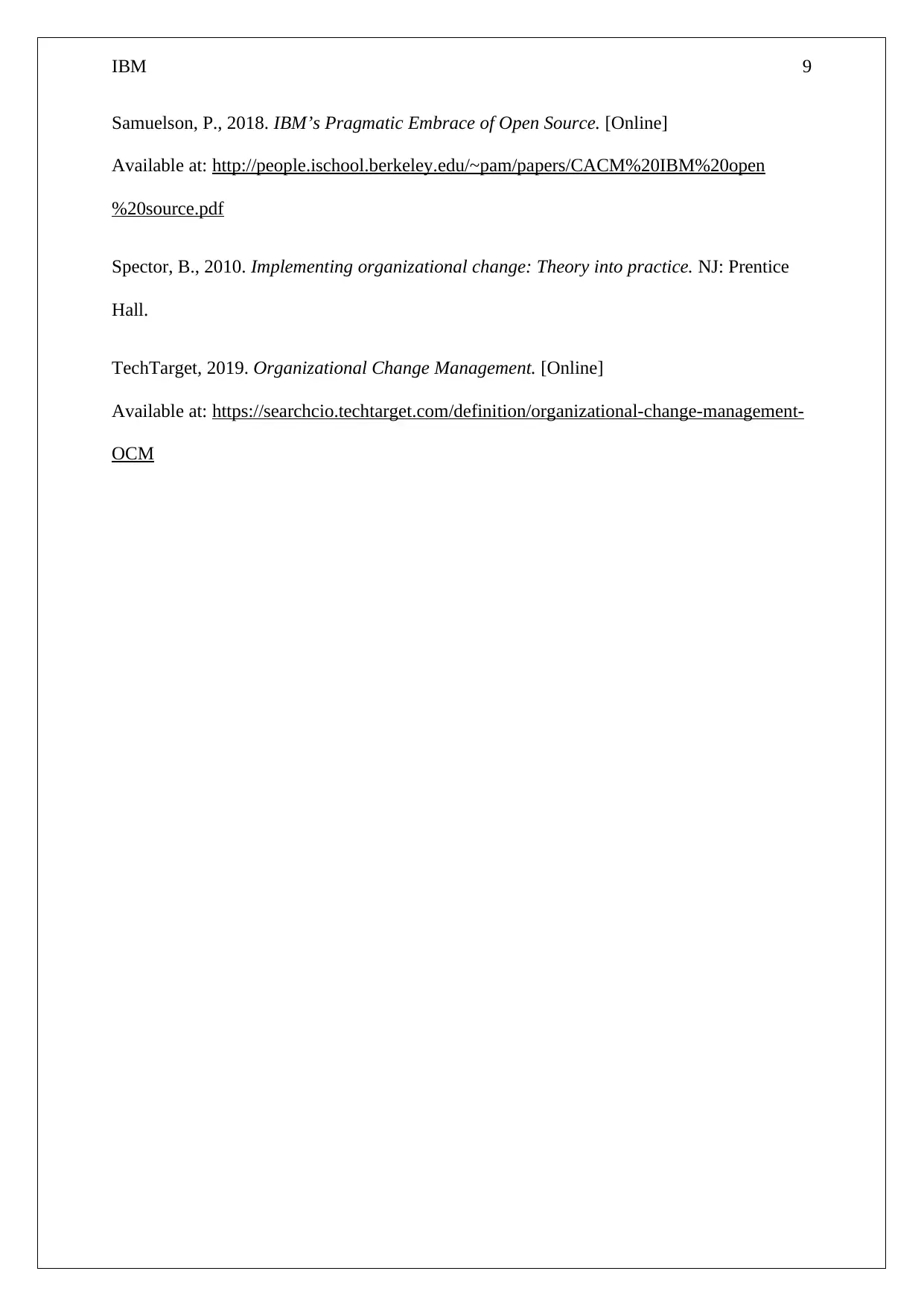
IBM 9
Samuelson, P., 2018. IBM’s Pragmatic Embrace of Open Source. [Online]
Available at: http://people.ischool.berkeley.edu/~pam/papers/CACM%20IBM%20open
%20source.pdf
Spector, B., 2010. Implementing organizational change: Theory into practice. NJ: Prentice
Hall.
TechTarget, 2019. Organizational Change Management. [Online]
Available at: https://searchcio.techtarget.com/definition/organizational-change-management-
OCM
Samuelson, P., 2018. IBM’s Pragmatic Embrace of Open Source. [Online]
Available at: http://people.ischool.berkeley.edu/~pam/papers/CACM%20IBM%20open
%20source.pdf
Spector, B., 2010. Implementing organizational change: Theory into practice. NJ: Prentice
Hall.
TechTarget, 2019. Organizational Change Management. [Online]
Available at: https://searchcio.techtarget.com/definition/organizational-change-management-
OCM
Paraphrase This Document
Need a fresh take? Get an instant paraphrase of this document with our AI Paraphraser
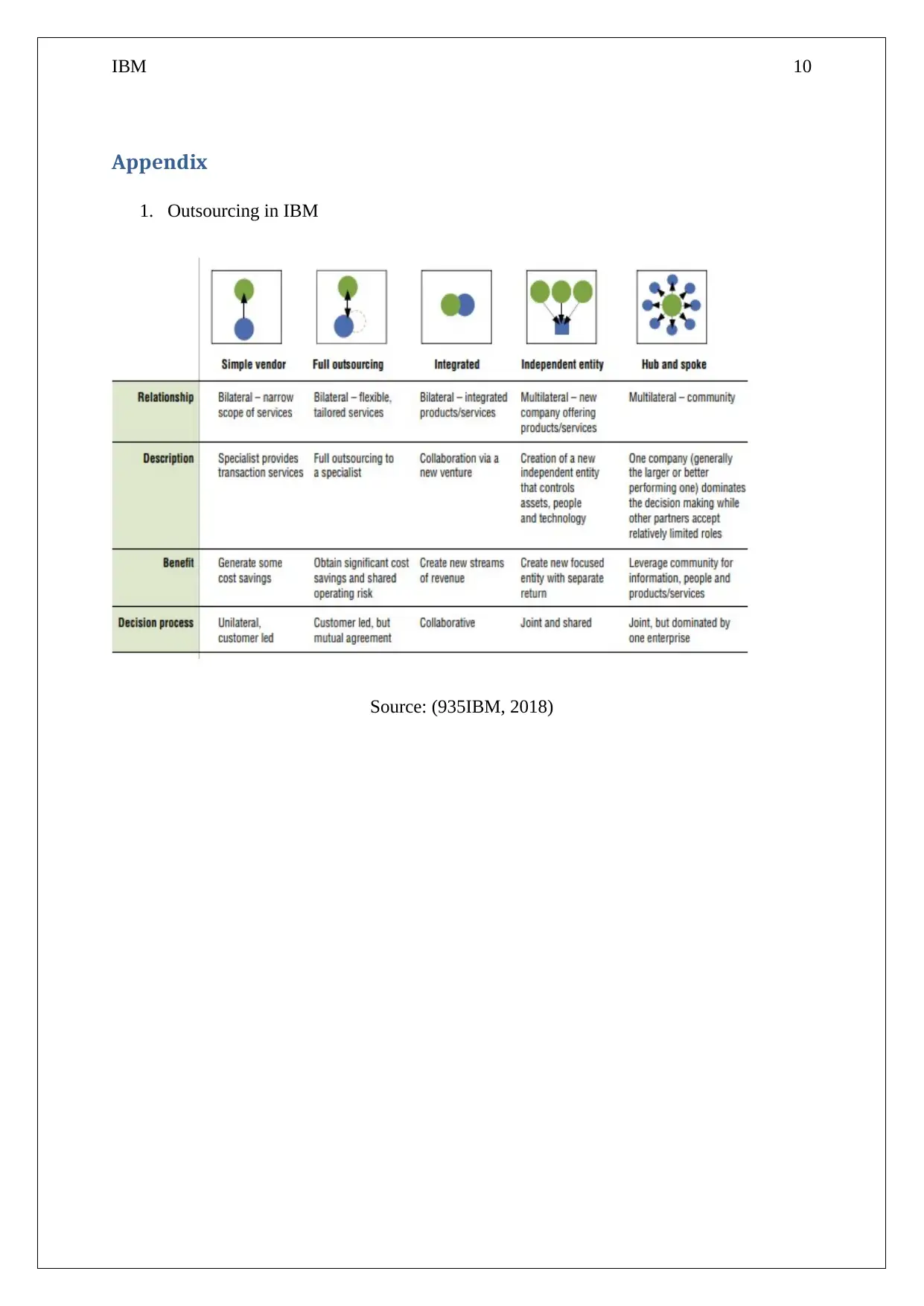
IBM 10
Appendix
1. Outsourcing in IBM
Source: (935IBM, 2018)
Appendix
1. Outsourcing in IBM
Source: (935IBM, 2018)
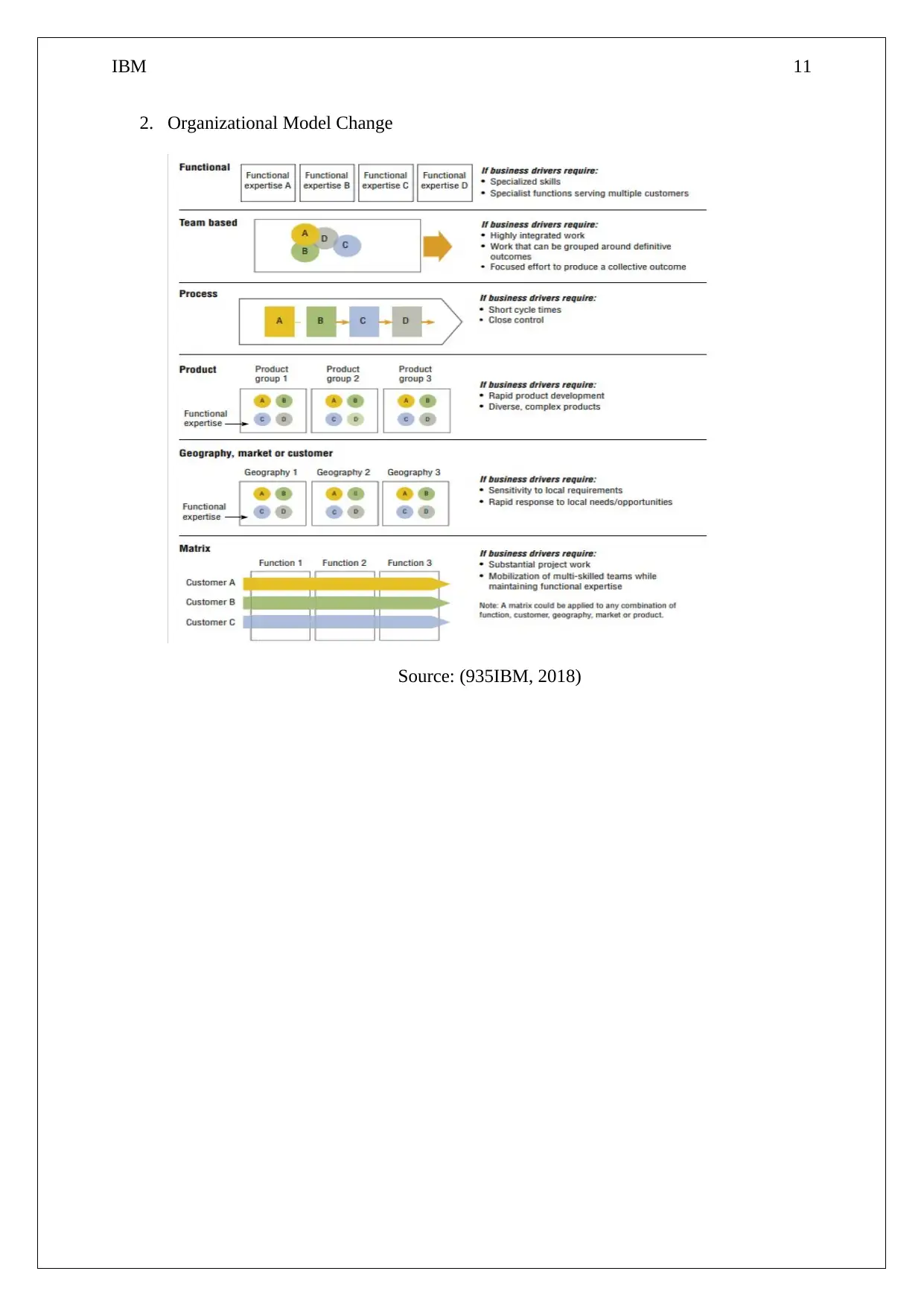
IBM 11
2. Organizational Model Change
Source: (935IBM, 2018)
2. Organizational Model Change
Source: (935IBM, 2018)
You're viewing a preview
Unlock full access by subscribing today!
1 out of 12
Related Documents
Your All-in-One AI-Powered Toolkit for Academic Success.
+13062052269
info@desklib.com
Available 24*7 on WhatsApp / Email
![[object Object]](/_next/static/media/star-bottom.7253800d.svg)
Unlock your academic potential
© 2024 | Zucol Services PVT LTD | All rights reserved.




